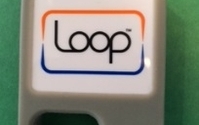Commentary
Mobile Payments & the Willingness to Pay
- by Chuck Martin , Staff Writer, February 19, 2014
 We may be about to see just how many people are seriously interested
in making mobile payments.
We may be about to see just how many people are seriously interested
in making mobile payments.
After months of early testing and with significant ($10+ million) funding, Boston-based Loop is making its mobile wallet available to the masses today.
The first iteration is a FOB that can be synced with an iPhone with the LoopWallet app (Android is promised for next month).
The FOB, housed in a rubber case, is also a credit card reader. The idea is that a consumer connects the reader to their phone, much like Square, and then swipes their credit cards to store them.
Once stored, the FOB can be connected to the phone and used at any checkout that can read traditional credit cards and the merchant doesn’t have to modify or add any hardware, one of the more significant hurdles in various mobile payment strategies.
The Loop approach is essentially to turn existing mag stripe credit card readers into mobile payment readers, since the Loop chip transmits the credit card information to the reader in a quick burst.
To use the FOB without the phone, you place it close to the credit card reader at checkout and press the button on the side. The credit card reader then behaves just as if a credit card was swiped.
The device is also a mobile wallet, since in addition to credit cards, other cards like loyalty and gift cards also can be scanned and stored.
Loop says the device is secure (PCI compliant, for mobile payment aficionados), with payment card data being encrypted and it can be set to generate dynamic card data each time a payment is made.
I’ve been trying an early version of the device for several months in many locations across the country.
Besides it working like a credit card, I’ve been struck by the consistent reactions of the salespeople at the actual register, as I wrote about last year (Mobile Payments & Replicating the Credit Card Experience) in an early demonstration by one of the founders.
Most of the reactions I’ve witnessed mirrored those.
In a rubber-hits-the road moment in mobile payments, we may find out the consumer interest level in mobile wallets and payments.
While the app is free, consumers have to pay $39 to be able to pay, to get the FOB.
For $99 they can get a phone case in a month that does essentially what the FOB does.
We may be about to see what, and if, consumers will pay to pay via mobile.




You can also do the same thing for free if your bank issues PayPass-enabled debit cards, you don't even have to swipe them, the terminal can read the chip. McDonalds supports Paypass and BB&T's consumer check cards offered it. Charging people a fee to make it easier to spend money seems counter-intuitive, the banks should be upgrading their cards as they replace them to support these type systems.
Sorry, Paypass is MasterCard's brand. Paywave is Visa's brand for the tap-and-go card you can use where the )))) symbol (the ) symbols get smaller) appears on the merchant's terminal.
Yes, Paul, the US market is a bit lagging when it comes to EMV and what you noted, which is known in the industry as Chip and Pin. We'll see if it's the payment or the mobile wallet feature of storing many cards that drives this type of feature. Thanks for the thoughts.
Thanks, Paul, am aware, and that symbols also generally means the carrier payment system Isis will work, thought there are issues there as well, which I've written about here.
The beauty of Loop Wallet vs. ISIS or NFC right now is that, except for gas pumps, I can do contactless payments virtually anywhere. The one drawback is at sit down restaurants where the POS terminal is usually at the waiter station or in the kitchen, but I have had no trouble instructing the waiter/waitress how to process the payment for me.
While security is potentially better with Loop, it definitely is better than a wallet filled with plastic. A great investment until all terminals accept NFC (not going to happen) or a fully integrated in-phone solution is introduced.
Thanks for the comments, Jim, you obviously are one of the early adopters (part of the Kickstarter contingency?) Those are good points about Loop, especially the idea that it works everywhere already. Obvious question, as stated above, is the size of the market that will pay for the capability. Will be interesting to see.